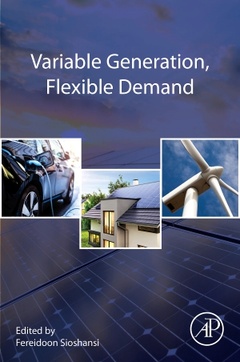Description
Variable Generation, Flexible Demand
Coordinator: Sioshansi Fereidoon
Language: English
Subject for Variable Generation, Flexible Demand:
Keywords
Aggregators; Ancillary services; Australia; Balancing cost; Baseline load; Battery storage; Behavioral economics; Brazil; Business models; CAISO; California duck curve; Capacity market; Capacity subscription; Consumer behavior and engagement; Consumer engagement; Customer behavior; Customer engagement; Day-ahead and intraday trading; Demand aggregation; Demand flexibility; Demand management; Demand reduction; Demand response; Demand side; Demand-side participation; Dispatchability; Distributed e
594 p. · 15x22.8 cm · Paperback
Description
/li>Contents
/li>Readership
/li>Biography
/li>Comment
/li>
Variable Generation, Flexible Demand looks at a future in which power system researchers, operators and analysts need to predict variable renewable generation and schedule demand to match it. Contributors survey the significant expansion in the role of flexible demand in balancing supply and demand in conjunction with flexible generation in ?peaking plants? and energy storage as the proportion of variable renewable generation rises in many systems across the world. Supported with case studies, the book examines practical ways that demand flexibility can play a constructive role as more systems move towards higher levels of renewable generation in their electricity mix.
Part One: Variable renewable generation 1. The evolution of California’s variable renewable generation 2. Variability of generation in ERCOT and the role of flexible demand 3. Rising variability of generation in Italy: The grid operator’s perspective 4. Integrating the rising variable renewable generation: A Spanish perspective
Part Two: Flexible demand 5. What is flexible demand; what demand is flexible? 6. Who are the customers with flexible demand, and how to find them? 7. How can flexible demand be aggregated and delivered to scale? 8. Electric vehicles: The ultimate flexible demand 9. Load flexibility: Market potential and opportunities in the US 10. Demand response in the US wholesale markets: Recent trends, new models and forecasts 11. What’s limiting flexible demand from playing a bigger role in the US organized markets? The PJM experience
Part Three: Coupling flexible demand to variable generation 12. Valuing consumer flexibility in electricity market design 13. Variable renewables and demand flexibility: Day-ahead versus intra-day valuation 14. The value of flexibility in Australia’s national electricity market 15. Demand flexibility and what it can contribute in Germany 16. Industrial demand flexibility: A German case study
Part Four: Implementation, business models, enabling technologies, policies, regulation 17. Market design and regulation to encourage demand aggregation and participation in European wholesale markets 18. Do time-of-use tariffs make residential demand more flexible? Evidence from Victoria, Australia 19. Empowering consumers to deliver flexible demand 20. Markets for flexibility: Product definition, market design and regulation 21. Energy communities and flexible demand 22. Flexible demand: What’s in it for the customer?
Grid operators. Energy system operators. Electric utilities. Regulators and policy makers across the electric power sector. Companies developing flexible demand services or options. Technology companies working on aggregating & delivering demand response
- Examines practical ways that demand flexibility can play a constructive role in future energy systems
- Reviews the vital role of market design, business models, enabling technologies, policies and regulation in implementation of flexible demand
- Includes detailed case studies that address the role of flexible demand across transitioning power markets




